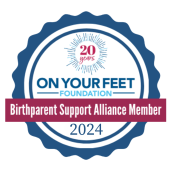If you’re considering making an adoption plan, knowing how open adoption works can bring a sense of clarity and confidence. At its core, open adoption is built on honest communication, mutual respect, and a shared understanding between you and the adoptive family.
So, how does it actually work?
When you choose open adoption, you and the adoptive parents agree on what kind of ongoing contact you’ll have after placement. This might include:
This contact can be outlined in something called a Post Adoption Contact Agreement. It’s a plan you create together, ideally before placement, that sets expectations and boundaries for the future. It might include how often you’ll communicate, what form that communication takes, and how flexible the arrangement can be in the future.
What birth parents should know about open adoption is that these agreements are typically built around the best interest of the child while also respecting the emotional needs and comfort level of both you and the adoptive family. In some states, these agreements may be legally recognized, while in others, they’re based on trust and mutual respect.
Over time, your relationship may grow and change, and that’s okay. The best open adoptions are those where everyone keeps an open line of communication, checks in when needed, and understands that the ways you stay in contact can ebb and flow over time.
The goal of open adoption is to maintain a connection that benefits your child while honoring your place in their story. You still matter. Your presence and love still matter.
Let’s clear up one big misconception right away: open adoption doesn’t mean you’re co-parenting your child. Once you sign your consent or surrender, you are relinquishing parental rights and granting those rights to the adoptive parents.
While open adoption allows you to have ongoing contact with your child and the adoptive family, the adoptive parents will handle all the parenting responsibilities. You’re not expected to make day-to-day decisions or carry parental duties.
A great thing about open adoption is that your plan for contact can change as your needs or the adoptive family’s needs shift over time. Maybe you’ll want more contact down the line, or maybe you’ll feel comfortable reducing it. Either way, when you establish a trusting relationship through open adoption, you and the adoptive family can adjust your plan for contact in a way that supports everyone.
When considering what birth parents should know about open adoption, flexibility is key. Your relationship with your child and their adoptive parents can naturally evolve, creating a situation that feels best for everyone.
Open adoption can offer incredible comfort and connection, but it can also be emotionally complex. Seeing your child happy and thriving with their adoptive family may bring peace, but that doesn’t mean you won’t also feel sadness, grief, or the ache of wanting to be closer. These feelings are real, and they’re normal.
The emotional effects of open adoption aren’t always predictable. You might feel strong and grounded one day, then find yourself overwhelmed the next. Your emotions matter, and there’s no one “right” way to feel. You’re allowed to feel joy and pain at the same time. You’re allowed to hold pride in your decision and still have moments of heartbreak.
That’s why emotional support matters so much. Having people who understand what you’re going through can help you process the highs and lows. Talking to a counselor, connecting with a support group, or simply sharing your story with someone who’s walked this path can make a huge difference.
What birth parents should know about open adoption is that support doesn’t end with placement. You deserve continued care and compassion, whether it’s through therapy, check-ins with your adoption agency, or conversations with other birth parents who truly get it.
You’re allowed to ask questions, lots of them. This is your decision, and you deserve full clarity before you move forward. If you’re wondering what birth parents should know about open adoption, one of the most important things is this: ask anything that helps you feel informed and safe.
Here are some thoughtful questions you can bring up when you’re getting to know potential adoptive parents:
Bringing these topics up early helps you understand if you’re on the same page. It also lays the foundation for mutual respect, something every healthy open adoption contact agreement needs.
Now that we’ve talked about what birth parents should know about the emotional side of open adoption, let’s get into something practical: your open adoption contact agreement. This document (sometimes informal and verbal, sometimes written and legal, depending on your state) spells out how you’ll stay in touch after placement.
And here’s the good news: you help shape it.
You and the adoptive parents talk about what kind of contact feels right, maybe that’s monthly photo updates, a phone call on birthdays, or in-person visits a few times a year. These choices are all part of your open adoption contact agreement, and the goal is to make sure both sides are comfortable, clear, and on the same page.
What birth parents should know about open adoption is that the contact plan is built on trust. It’s not legally enforceable in every state, but when families work together with openness and respect, it can be an incredibly positive, lasting connection.
Life changes. So do people. One of the biggest things about open adoption is that your plan doesn’t have to be frozen in time.
You and the adoptive family might start with a certain arrangement, and over time, it might grow, or scale back. That doesn’t mean the adoption isn’t working. It means you’re all figuring it out together.
Some birth parents begin with just photos and eventually feel ready for visits. Others find that too much contact is emotionally overwhelming and ask to pull back. As long as everyone communicates with honesty and care, your open adoption contact agreement can reflect those changes.
A respectful relationship with the adoptive parents can make all the difference. Think of it less like a formal agreement and more like a growing connection. You’re not co-parents, but you’re connected by the child you both love.
With open adoption, strong communication is the foundation of a healthy relationship. That doesn’t mean constant updates or deep emotional talks. It can be as simple as staying kind, listening well, and speaking up if something doesn’t feel right.
The open adoption contact agreement helps set those boundaries. But the actual bond? That’s built over time, through honesty, flexibility, and a shared goal of doing what’s best for the child.
Open adoption is layered. It can bring both comfort and challenge. But it can also offer a sense of connection and peace that lasts far beyond placement. With the right support, clear communication, and a willingness to grow with the process, open adoption can create space for healing, honor, and lifelong meaning for you and your child.




